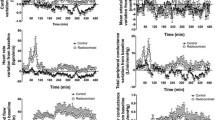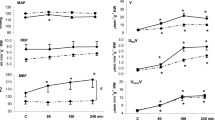Summary
The effects of felodipine, a dihydropyridine vasodilator, were investigated in a canine model of hemorrhagic shock. Mongrel dogs were anesthetized with sodium pentobarbital and subjected to hemorrhagic shock by allowing the animals to bleed into a reservoir. After maintaining the hypotensive state (mean blood pressure: 40–60 mmHg) for a period of 150 min, the blood was reinfused and the recovery of the various parameters were monitored for an additional 120 min. These studies were conducted in three different groups of dogs: (A) controls, (B) felodipine, 0.01 μmol/kg i.v., was administered before reinfusion of the blood and (C) felodipine, 0.01 μmol/kg i.v., was administered prior to hemorrhage. In all the three groups, arterial blood pressure returned essentially to pre-hemorrhage levels following reinfusion; in the groups A and B, there was about 80% recovery of the cardiac output, whereas in the group C cardiac output returned completely to the basal values. During the hemorrhagic hypotension, renal and mesenteric blood flows fell to 10–40% of the basal values in all the three groups. In the control group A, there was only 40 to 45% recovery in the renal and mesenteric flows after reinfusion indicating sustained vasoconstriction in these vascular beds. Felodipine administration before reinfusion (group B), resulted in 70% to 90% recovery in the renal and mesenteric flows after reinfusion. In the group C (felodipine before hemorrhage) there was 85% recovery in the renal flow and 100% in the mesenteric blood flow after reinfusion. The observations made in this study suggest that felodipine, an arteriolar dilator, may be clinically useful in restoring organ blood flows which are seriously compromised during the hemorrhagic shock.
Similar content being viewed by others
References
Bellamy RF, Pedersen DC, Guzman de LR (1984) Organ blood flow and cause of death following massive hemorrhage. Circ Shock 14:113–127
Blahitka J, Rakusan K (1977) Blood flow in rats during hemorrhagic shock: Differences between surviving and dying animals. Circ Shock 4:79–93
Bolt GR, Saxena PR (1984) Acute systemic and regional hemodynamic effects of felodipine, a new calcium antagonist in conscious renal hypertensive rabbits. J Card Vase Pharmacol 6:707–712
Boström SL, Ljung B, Mårdh S, Forsen S, Thulin E (1981) Interaction of the antihypertensive drug felodipine with calmodulin. Nature 292:777–778
Campion DS, Lynch LJ, Rector Jr FC, Carter N, Shires, GT (1969) Effect of hemorrhagic shock on transmembrane potential. Surgery 66:1051–1059
Carroll RG, Farner PL (1978) Verapamil pretreatment prolongs survival in a canine model of hemorrhagic shock. Fed Proc 46(4):1250 (Abstract)
Crowell JW, Guyton A (1961) Evidence favoring a cardiac mechanism in irreversible hemorrhagic shock. Am J Physiol 201:893–901
Gifford RM, MacCannel KL, McNay JL, Hass JA (1986) Changes in regional blood flow induced by dopamine and isoproterenol during experimental hemorrhagic shock. Can J Physiol Pharmacol 46:847–851
Hackel DB, Mikat EM, Whalen G, Reimer K, Rochlani SP (1979) Treatment of hemorrhagic shock in dogs with verapamil: Effects on survival and on cardiovascular lesions. Lab Invest 41:356–359
Hackel DB, Mikat EM, Reimer K, Whalen G (1981) Effects of verapamil on heart and circulation in hemorrhagic shock in dogs. Am J Physiol 10:H12-H17
Haglund U, Abe T, Ahren C, Braide I, Lundgren O (1976) The intestinal mucosal lesions in Shock 11: The relationship between the mucosal lesions and the cardiovascular dearrangement following regional shock. Eur Surg Res 8:448–460
Hamed AT, Ginos JZ, Ekas Jr RD, Jandhyala BS, Lokhandwala MF (1983) Renal hemodynamics in hemorrhagic hypotension: Studies on the effects of pre- and postjunctional dopamine receptor agonists. J Card Vase Pharmacol 5:207–212
Horton JW, Tuggle DW, Vaught MC, Taylor SE (1983) Effects of verapamil on cellular function in hemorrhagic shock. Circ Shock 10:239–240
Jandhyala BS (1985) Studies on the effects of felodipine on the vascular resistance and reactivity in pentobarbital anesthetized dogs. Naunyn-Schmiedeberg's Arch Pharmacol 329:398–403
Johnsson G, Murray G, Tweddel A, Hutton I (1983) Haemodynamic effects of a new vasodilator drug, felodipine in healthy subjects. Eur J Clin Pharmacol 24:49–53
Lefer AM (1982) The pathophysiologic role of myocardial depressant factor as mediator of circulatory shock. Klin Wochenschr 60:713–716
Liu ZM, Abel FL, Rodriguez LF (1984) The effects of phentolamine and isoproterenol in experimental hemorrhagic shock in the dog. Circ Shock 14:1–11
Ljung B (1984) Vascular selectivity of felodipine. Drugs 29 (Supplement 2):46–58
Lundgren O, Lundwall J, Mellander S (1964) Range of Sympathetic discharge and reflex vascular adjustment in skeletal muscle during hemorrhage. Acta Physiol Scand 62:380–390
Markov AK, Oglethorpe N, Young DB, Hellems HK (1981) Irreversible hemorrhagic shock: Treatment and cardiac pathophysiology. Circ Shock 8:9–19
Nordlander M, DiBona GF, Ljung B, Yao T, Thoren P (1985) Renal and cardiovascular effects of acute and chronic administration of felodipine to SHR. Eur J Pharmacol 113:25–36
Sarnoff SJ, Case RB, Waithe PE, Issacs JP (1954) Insufficient coronary flow and myocardial failure as a complicating factor in late hemorrhagic shock. Am J Physiol 176:439–446
Selkurt EE, Alexander RS, Patterson MB (1947) The role of the mesenteric circulation in the irreversibility of hemorrhagic shock. Am J Physiol 149:732–743
Selkurt EE (1969) Primate kidney function in hemorrhagic shock. Am J Physiol 217:955–961
Share L (1968) Control of plasma ADH: Role of atrial and arterial receptors. Am J Physiol 215:1384–1389
Smith EE, Crowell JW (1964) Effect of hemorrhagic hypotension on oxygen consumption of dogs. Am J Physiol 207:647–654
Trump BF, Berezesky IK, Chang SH, Pendergrass RE, Mergner WJ (1979) The role of ion shifts in cell injury. In: O'Hare AMF (ed) Scanning electron microscopy, vol III. SEM Inc IL pp 1–14
Truniger BS, Rosen SM, Grandchamp A, Strebel H, Kriek HR (1971) Redistribution of renal blood flow in hemorrhagic hypotension: Role of renal nerves and circulating catecholamines. Eur J Clin Invest 1:277–280
Vaghy PL, Wiliams JS, Schwartz A (1987) Receptor pharmacology of calcium entry blocking agents. Am J Cardiol 59:9A–17A
Vanhoutte PM (1982) Calcium entry blockers and vascular smooth muscle. Circulation 65 (Suppl 1):11–19
Vargish T, Reynolds DG, Gurll NJ, Lechner RB, Holaday JW, Faden AI (1980) Naloxone reversal of hypovolemic shock in dogs. Circ Shock 7:31–38
Werle JM, Crosby RS, Wiggers CJ (1942) Observations on hemorrhagic hypotension and hemorrhagic shock. Am J Physiol 136:301–420
Wiggers CJ, Werle JM (1942) Cardiac and peripheral resistance factors as determinants of circulatory failure in hemorrhagic shock. Am J Physiol 136:421–429
Zweifach BW, Fronek A (1975) The interplay of central and peripheral factors in irreversible hemorrhagicshock. Prog Cardiovasc Dis 18:147–180
Author information
Authors and Affiliations
Additional information
Send offprint requests to B. S. Jandhyala
Rights and permissions
About this article
Cite this article
Sabouni, M., Hodge, K. & Jandhyala, B.S. Restoration of renal and mesenteric hemodynamics by felodipine in a canine model of hemorrhagic shock. Naunyn-Schmiedeberg's Arch Pharmacol 337, 465–470 (1988). https://doi.org/10.1007/BF00169541
Received:
Accepted:
Issue Date:
DOI: https://doi.org/10.1007/BF00169541




